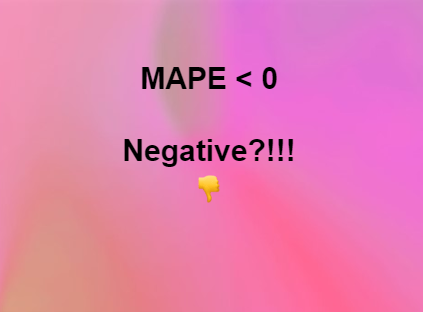Help my MAPE is negative!
I hear frequently calls for help saying MAPE is high or saying MAPE is unreliable. Recently we encountered two situations where the calculated MAPE & WMAPE were negative.
When your MAPE is negative, it says you have larger problems than just the MAPE calculation itself. Let us examine this a bit.
Simply put,
MAPE = Abs (Act – Forecast) / Actual. Since the numerator is always positive, the negativity comes from the denominator.
Your actual demand is negative – meaning first of all you are not using the True Demand concept in your demand planning process. Your returns in a particular period outweighed the sales and your net demand became negative.
This flaw is not just limited to that SKU but it is pervasive across all SKUs – your calculation algorithm essentially understates the demand across all of your SKUs since returns are buried in it.
It is important to understand metrics in any process – Metrics tell you where you are. Learn the differences between MAPE, WMAPE, MASE, RMSE, and MAD/Mean Ratio, and be prepared to compile a demand metrics scorecard.
The negative happens when your denominator is negative – when the returns overwhelm the orders in a month. Please see the details in the discussion.
When the denominator is zero, the MAPE will become infinite. Smaller the actual compared to forecast and when it approaches zero, then we know the MAPE as such is very large. So setting this to zero is not a good approximation.
All we can say is that the MAPE is inestimable.
What we do for clients is to set a flag in the system that will produce a 9999% for that SKU when reported at the item level. But the above should not affect the total MAPE for all SKUs.
Take a look at our demand metrics template at
http://demandplanning.net/DemandMetricsExcelTemp.htm.
Now turning our attention to the discussion on Returns, we need to carefully review the concept of True Demand.
Returns may be important but not for demand planners to review and adjust. Returns are so granular and so inter-temporal, that bringing them into an aggregate planning system will only cause chaos.
Large and significant returns are a critical business risk – much more important than just Demand Planning. More is at stake for the business and the company’s well-being. The goal should be to study the returns and minimize them in the future.
IF I see a returns number as a separate row in my Demand Planning View, what should I do as a demand planner?
Adjust this in the current month? How do I know which month it was originally shipped from? In fact, an aggregate Returns number for the month or week could be from several returns and from several shipments that have different original shipment lags…………..
There were many private requests for the concept on True Demand and my presentation. You can download this presentation at
http://demandplanning.net/DemandDownload.htm.
Please contact us if you need more info or consulting help on properly defining Demand for your Supply chain planning process.
Please visit http://demandplanning.net/consulting.htm to know about our services offerings at DPLLC.
Follow Us to keep updated on our regular content in the SCM space –
Facebook | Twitter | Instagram | Youtube | Linkedin


Leave a Reply